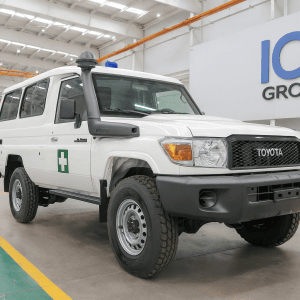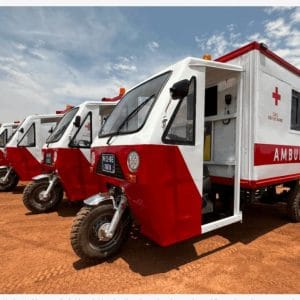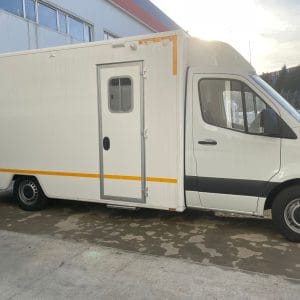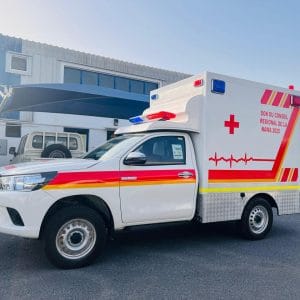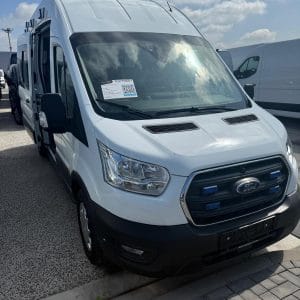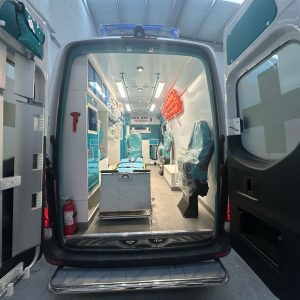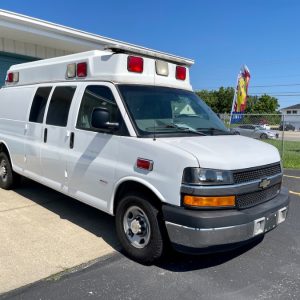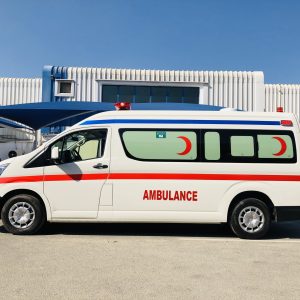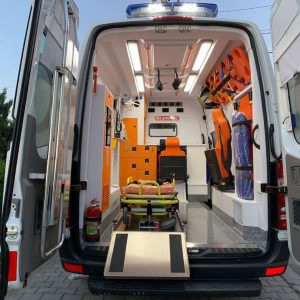The Toyota Land Cruiser Box Ambulance is a purpose-built emergency medical services vehicle designed for rugged terrain and difficult access situations. Based on the iconic Toyota Land Cruiser SUV platform, it combines off-road capability with customized medical transport functionality.
Toyota has decades of experience building Land Cruisers for humanitarian and emergency response uses. The Land Cruiser Box Ambulance represents the pinnacle for medical field vehicles. It allows emergency personnel to reach patients in remote locations, during natural disasters, or in regions with underdeveloped infrastructure.
This ambulance provides extensive medical equipment within a protected patient compartment. The customized rear box design also enables loading and unloading of stretchers with ease. And the reliable Land Cruiser chassis delivers safety and performance across rough roads, inclement weather, and off-road conditions.
With its versatility, durability, and advanced capability, the Toyota Land Cruiser Box Ambulance serves as a critical emergency response vehicle for medical teams operating in challenging environments worldwide. It embodies Toyota’s commitment to building vehicles that save lives.
Exterior Design
The Toyota Land Cruiser Box Ambulance features a rugged yet refined exterior designed for medical transport and emergency response. With its body-on-frame construction, the Land Cruiser Ambulance provides excellent ground clearance and approach/departure angles to handle off-road terrain.
- Dimensions – The Land Cruiser Ambulance has a length of 5,815mm, width of 1,980mm, and height of 1,900mm. The long wheelbase of 3,180mm provides a stable platform.
- Ground Clearance – With a ground clearance of 215mm, the Land Cruiser Ambulance can clear rocks, ruts, and other obstacles when traveling off-road. This allows access to remote locations.
- Approach/Departure Angles – The approach angle is 31 degrees and departure angle is 24 degrees, enabling the Land Cruiser Ambulance to climb steep hills or inclines and descend without scraping the bumpers. This is critical for medical response in rugged areas.
The Land Cruiser Ambulance’s purpose-built exterior provides the clearance, angles, and dimensions needed for medical professionals to access patients in the most remote locations. The off-road capabilities ensure emergency medical services can reach those in need.
Interior Design
The Toyota Land Cruiser Box Ambulance offers generous interior space to accommodate medical equipment and personnel. The interior layout is designed for functionality and practicality.
The ambulance has seating for up to 7 people including the driver, with options for bench seats or individual captain’s chairs in the rear. This allows for transport of medical personnel along with the patient. There is ample legroom and headroom, even for taller passengers.
Storage capacity is a key advantage of the Land Cruiser ambulance. The rear cargo area provides abundant space for a stretcher, medical bags, oxygen tanks and other medical gear. There are storage compartments and cabinets to keep supplies organized yet easily accessible.
The durable interior materials are designed to withstand heavy use and cleaning. The floors are covered in a waterproof, anti-bacterial material for easy cleaning. Interior lights are bright LEDs to illuminate the cabin at night.
Overall, the Toyota Land Cruiser Box Ambulance balances comfort and functionality. Medical teams have sufficient space to work and transport patients comfortably even on rough terrain.
Performance
The Toyota Land Cruiser Box Ambulance is powered by a 4.5L V8 twin turbo diesel engine that produces 381 horsepower and 516 lb-ft of torque. This powerful engine is paired with a 6-speed automatic transmission and full-time 4-wheel drive.
Despite its size and capabilities, the Land Cruiser Box Ambulance delivers decent fuel economy. It is rated at 13 mpg city and 17 mpg highway. The large fuel tank provides it with an impressive driving range as well.
The V8 turbo diesel provides the Box Ambulance with strong acceleration and towing power. It can tow up to 8,100 pounds when properly equipped, which is more than enough for medical equipment and supplies. The advanced full-time 4WD system provides exceptional traction and off-road prowess.
Overall, the Toyota Land Cruiser Box Ambulance has a very capable powertrain that provides strong performance on-road and off while still returning respectable fuel efficiency. The powerful V8 engine gives it ample power for medical duties while the rugged drivetrain allows it to access remote locations.
Off-Road Capabilities
The Toyota Land Cruiser Box Ambulance features impressive off-road capabilities thanks to its robust 4WD system, advanced traction control, and excellent articulation.
4WD System
The Land Cruiser utilizes a full-time 4WD system that provides excellent traction and maneuverability on all terrains. It has a 2-speed transfer case with selectable low-range, allowing the driver to shift into 4-LO for challenging off-road conditions. The truck is equipped with a locking center differential for increased traction when needed.
Traction Control
To further enhance off-road prowess, the Land Cruiser Box Ambulance has an advanced traction control system. It actively brakes wheels that are slipping to redirect torque to wheels with grip. This improves stability and prevents getting stuck when driving over loose or uneven terrain.
Articulation
With a rugged body-on-frame design, the Land Cruiser Ambulance can flex and articulate well over uneven terrain. Long suspension travel and high ground clearance allow the truck to traverse obstacles without bottoming out. This articulation enables all four wheels to maintain contact with the ground even on very rugged landscape.
The robust 4WD hardware, advanced traction aids, and excellent articulation give the Toyota Land Cruiser Box Ambulance impressive off-road capabilities for accessing remote locations and disaster sites. Its off-road technologies allow it to conquer tough terrain that would stop most other emergency vehicles.
Safety
The Toyota Land Cruiser Box Ambulance prioritizes safety for both patients and medical personnel. It comes equipped with a range of active and passive safety features to protect occupants in the event of an accident.
Some key safety features include:
- Vehicle Stability Control (VSC) – This system helps maintain traction and prevent skids when cornering on slippery surfaces. It detects loss of lateral traction and automatically adjusts engine power and braking to help keep the vehicle on course.
- Anti-lock Braking System (ABS) – The ABS helps prevent wheels from locking up and skidding during emergency braking situations. It pulses the brakes rapidly to allow the driver to maintain steering control during hard braking.
- Emergency Brake Assist – This system provides extra brake pressure when the driver slams on the brakes in an emergency situation. It helps shorten stopping distances in urgent braking situations.
- Front, side, and curtain airbags – Airbags provide cushioning to help protect occupants in the event of a collision. The Land Cruiser Box Ambulance has airbags for both front row occupants as well as side curtain airbags to help protect patients in the rear.
The Toyota Land Cruiser Box Ambulance performs well in crash testing, designed to meet or exceed rigorous safety standards. In frontal crash tests conducted by the National Highway Traffic Safety Administration (NHTSA), it achieves 5 out of 5 stars. It also earns top ratings from the Insurance Institute for Highway Safety (IIHS) in side impact crash tests.
With its combination of active safety features and excellent crash test results, the Land Cruiser Box Ambulance provides medical teams with the protection they need when responding to emergencies on the road. Its safety capabilities give peace of mind when transporting injured patients to receive urgent care.
Medical Equipment
The Toyota Land Cruiser Box Ambulance is equipped with state-of-the-art medical equipment to provide emergency care while transporting patients. It has ample storage space to carry all necessary medical gear.
The ambulance features overhead LED interior lighting to illuminate the patient care area. Oxygen outlets and suction ports are installed above the patient cot to provide oxygen therapy and suction during transport.
It contains cabinetry to store medical supplies like bandages, gauze, gloves, masks, and more. The cabinets come with adjustable dividers to customize storage. There are dedicated sharps disposal units for safe needle disposal.
A 170L refrigerator maintains temperature-sensitive pharmaceuticals like insulin, vaccines, and IV fluids. The fridge can run on shore power, vehicle power, or an external battery.
The ambulance has a mounted AED (automated external defibrillator) for cardiac emergencies. A pulse oximeter monitors patient oxygen saturation. A blood pressure cuff allows medics to assess vitals.
A ceiling-mounted IV hook holds IV bags securely. The ambulance also contains a stretcher, backboard, cervical collars, and other patient handling equipment. O2 cylinders are stored in a dedicated compartment.
With ample storage, lighting, power outlets, and installed medical devices, the Land Cruiser Box Ambulance provides a mobile emergency room to deliver critical care.
Technology
The Toyota Land Cruiser Box Ambulance comes equipped with advanced technology to assist drivers and provide critical information.
Infotainment and Navigation
The ambulance has a large 8-inch touchscreen display that provides access to the infotainment system and navigation. It utilizes a fast and intuitive interface that allows quick access to media, phone connectivity via Bluetooth, and more. The navigation system features full mapping of the United States and Canada and enables efficient routing to destinations.
Driver-Assist Technologies
Toyota has outfitted the Land Cruiser ambulance with helpful driver-assist and active safety features. This includes a rearview camera to enhance visibility when reversing, as well as Blind Spot Monitoring that alerts drivers to vehicles in adjacent lanes. Additional technologies like Lane Departure Alert and Forward Collision Warning further aid the driver in staying focused on the road.
Diagnostic and Communication Systems
The ambulance has built-in diagnostic systems to monitor the status of the engine, drivetrain, and other critical components. This allows for early detection of potential issues. There is also high-speed LTE connectivity to enable quick communication and data transfers between the vehicle and healthcare facilities. This is useful for sending patient vitals ahead while in transit.
Pricing
The Toyota Land Cruiser Box Ambulance has a base MSRP of $85,000. This is just for the standard ambulance configuration without any additional options.
Customers have several upgrade options available:
- 4WD system – $2,000
- Premium LED lighting package – $1,500
- Enhanced climate control system – $3,000
- Satellite navigation system – $2,500
- Upgraded patient monitoring system – $5,000
Fully loaded with all options, the Land Cruiser Box Ambulance can cost over $100,000. However, most customers tend to stick with the base model or just add one or two of the more popular options like the 4WD or climate control system.
Overall, the pricing is competitive for a specialty vehicle like this, given its capabilities and Toyota’s reputation for reliability. The ambulance conversion is where most of the cost comes from. Those looking for a budget option may want to consider a used model. But new Land Cruiser Box Ambulances hold their value well on the secondary market.
Competitors
The Toyota Land Cruiser Box Ambulance faces competition from other automakers that produce ambulance variants of their SUVs. The key competitors include:
Mercedes-Benz Sprinter Ambulance – The Sprinter is a popular ambulance platform known for its versatility, cargo capacity, and smooth ride. Key advantages of the Sprinter include excellent maneuverability, various length configurations, and Mercedes’ safety technologies. However, the Sprinter lacks the rugged off-road capabilities of the Land Cruiser.
Ford Transit Ambulance – Like the Sprinter, the Ford Transit offers ambulance builders a highly customizable commercial van platform. The Transit offers a lower cost option and good cargo capacity. But the Transit lacks the passenger space, off-road abilities, and prestige of the Land Cruiser.
Nissan Patrol Ambulance – The Patrol is Nissan’s largest SUV and a top Land Cruiser competitor in overseas markets. The Patrol ambulance can go off-road and has a similar box-style rear. But the Land Cruiser has better reliability ratings and likely better resale value.
The Land Cruiser remains highly competitive in the ambulance SUV segment thanks to its proven capabilities, Toyota’s reputation for durability, and the model’s prestige. The Land Cruiser Box Ambulance is optimized for rugged terrain with off-road enhancements the Sprinter and Transit vans cannot match. For ambulance services needing to reach remote locations in areas with unpaved roads, the Land Cruiser is difficult to beat.



